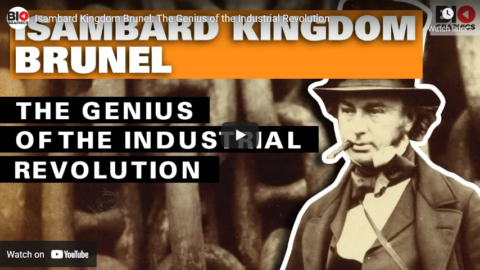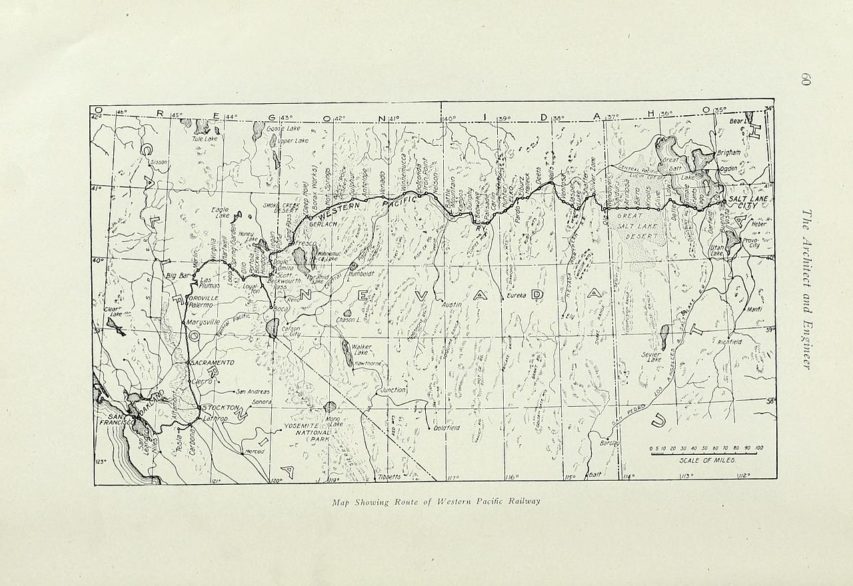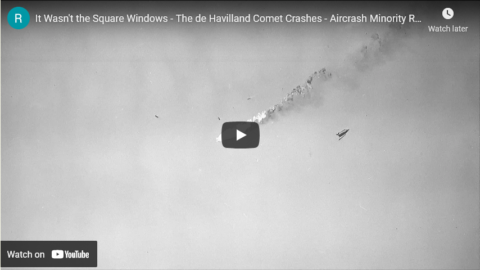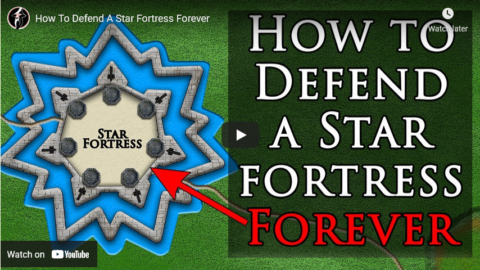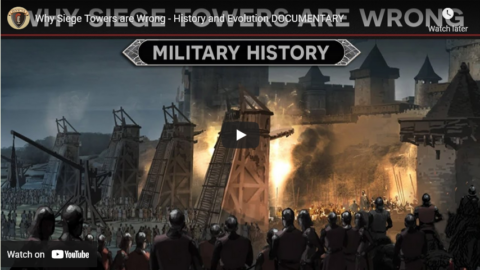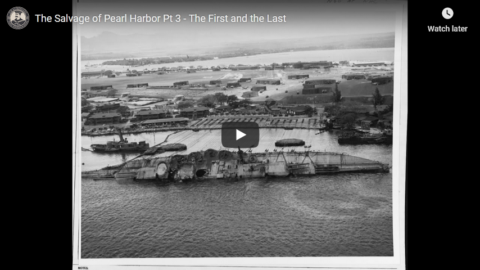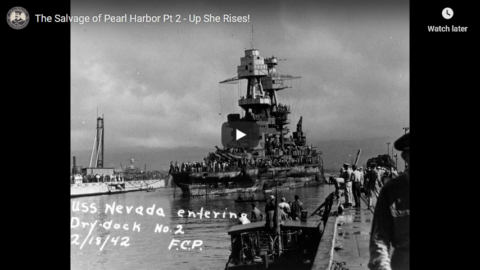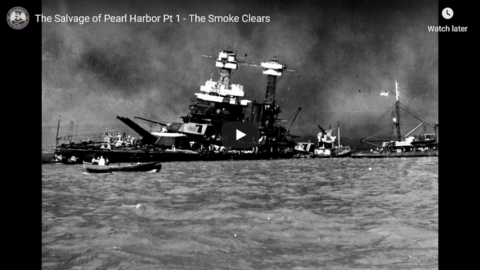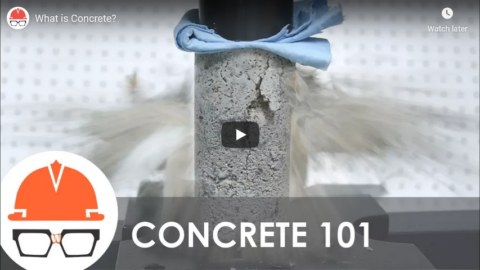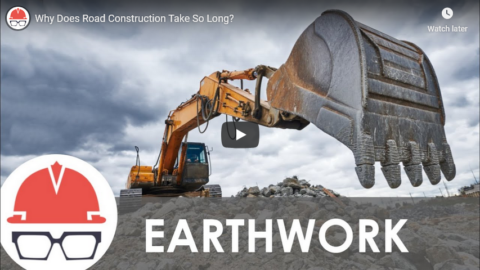World War Two
Published 31 Aug 2021German military doctrine is all about mobility and operational maneuverability, but there comes a time in this war, well, several times, when an actual classic siege is called for. So how does the Wehrmacht respond to that call? Find out today.
(more…)
September 1, 2021
August 31, 2021
Isambard Kingdom Brunel: The Genius of the Industrial Revolution
Biographics
Published 23 Mar 2020Check out Brilliant: https://brilliant.org/biographics
Check out Business Blaze: https://www.youtube.com/channel/UCYY5…
This video is #sponsored by Brilliant.
TopTenz Properties
Our companion website for more: http://biographics.org
Our sister channel TopTenz: https://www.youtube.com/channel/UCQ-h…
Our Newest Channel about Interesting Places: https://studio.youtube.com/channel/UC…Credits:
Host – Simon Whistler
Author – Morris M.
Producer – Jennifer Da Silva
Executive Producer – Shell HarrisBusiness inquiries to biographics.email@gmail.com
Source/Further reading:
Oxford National Dictionary of Biography: https://www.oxforddnb.com/view/10.109…
Interesting podcast on his life: https://www.bbc.co.uk/programmes/b04n…
Britannica: https://www.britannica.com/biography/…
History Today: https://www.historytoday.com/archive/…
The Thames Tunnel: https://www.smithsonianmag.com/histor…
The atmospheric railway: https://www.theguardian.com/science/t…
SS Great Britain accident: https://www.ssgreatbritain.org/about-…
August 6, 2021
Fallen Flag — the Western Pacific Railroad

The Western Pacific company magazine Mileposts included this historical snippet in their 50th anniversary issue (courtesy of the Western Pacific Railroad Museum):
Virgil Bogue had become George Gould’s consulting engineer and recalling his surveys for the Union Pacific in the ’80’s, recommended Beckwourth Pass and the Feather River route. Remembering also an unhappy experience he had once had in locating any other road, only to find the whole route plastered with mining claims of dubious mineral value but through which rights of way must be negotiated, he advised Gould to form a “mining company” first. Accordingly the North California Mining Company was organized and soon nearly 600 placer claims were staked out, blanketing the entire proposed route across the mountains.
Gould turned the job over to the Denver and Rio Grande and its president, E.T. Jeffery, sent a field party under H.H. Yard west to locate the line. It was all top secret. The transit men and stake artists were forbidden even to let their wives know where they were. Letters could only be exchanged through the Denver office of the railroad. Two California corporations, the Butte and Plumas Railway and the Indian Valley Railway, were set up to be the figureheads.
[…]
George Gould still remained completely out of the picture and denied all connection with the project. Although he financed the new surveying parties that were immediately sent out to make the final location, he was forced, in the interests of this secrecy, to keep the Rio Grande engineers in the field as well. The absurd result was two hostile groups struggling to outwit each other and often on the point of exchanging pot shots, though both were actually on the same payroll.
After much chicanery and effort, the railway’s right of way through the Feather River Canyon, the next historically significant fight was securing access to the waterfront along San Francisco Bay, where the legal department of the Southern Pacific believed they had an ironclad monopoly of all the potentially useful access routes to salt water:
… the S.P. was fully confident that it would have but little difficulty in isolating the Western Pacific from a practical outlet on the Bay. The Santa Fe, only a few years before, had built its ferry slip way up at Point Richmond rather than attempt to crack the S.P. stronghold. Bartnett, after a hard struggle against the older railroad’s influence, did secure a small site on the mudflats of the Oakland Estuary. It would have made a miserably cramped ferry terminal but, from all appearances, the WP promoters had concluded it was the best they could do. Harriman’s forces sneered and relaxed. Gould’s were just beginning. Every move was carefully rehearsed and logistics figured to the last detail.
As the Oakland tidelands had gradually been filled in, the Government had extended the banks of San Antonio Estuary with rock quays called “training walls” in order to prevent silt from washing into the Oakland inner harbor channel. A dredger was often necessary to prevent the formation of a bar at the entrance of the channel. This dredger became the Trojan horse of the Gould attack.
On the night of January 5, 1906, the Western Pacific forces under Bartnett struck.
With 200 workmen and 30 guards armed with carbines and sawed-off shotguns, he used the dredging company as a front, and seizing the north training wall, began feverishly to lay a rough track. Most of the guards took up positions at the shore end of the U. S. training wall and maintained them night and day. Laborers snatched their sleep in shelter tents on the wave-washed rocks and the WP commissary department fed them. Scows rushed more rails and ties across the Bay to the end of the wall. Soon there was a mile of track on top of the rock wall.
Of course the Southern Pacific did not quietly accept this outrageous trespassing on domains it had held undisputed for more than half a century. Its legal department, fairly in convulsions, was whipping out the necessary papers for immediate appeal to the law. This was exactly what Bartnett had told Gould would happen and exactly what they both desired. For the courts, as Bartnett had felt sure they would, held that the Southern Pacific title to the waterfronts had not progressed westward with the shoreline as the tidelands and marshes had been filled in, but was valid only to the low tide line of 1852. The S.P.’s “waterfront” therefore was by now well inland, and the new marginal land surrounding it was the property of the city.
The city government was duly grateful to the new railway for almost literally liberating the city’s shoreline from the grip of the Southern Pacific. With most of the legal complications (and paramilitary solutions) out of the way, construction of the full line began in earnest, as Arthur L. Lloyd picks up the story:
Construction started in Salt Lake City. The line would be all 90-lb. rail and have no curve exceeding 10 degrees. To keep to the 1-percent maximum grade, the full-circle Williams Loop was built between Massack and Spring Garden, Calif., and another partial one, Arnold Loop, west of Wendover, Nev.
Work also went from Oakland eastward, and the last spike marking completion was driven on the bridge over Spanish Creek at Keddie, Calif., on Nov. 1, 1909. There was no ceremony. Section foreman Leonardo de Tomasso, age 25, did the honors with a standard steel spike. Arthur Keddie was still around, though. He rode WP’s first passenger train, and he spoke from the Plumas County Courthouse steps in Quincy, Calif., on Nov. 21, 1910.
WP was dispatched completely by train orders and timetable; its only block signals were on the paired track between Weso (Winnemucca) and Alazon (Wells) in Nevada, where eastbound WP and Southern Pacific trains used WP, while both roads’ westbounds used SP.
Route map of the Western Pacific, published in The Architect & Engineer of California and the Pacific Coast, 1905.
WP’s map was simplicity itself, highlighted by a main line from San Francisco Bay to Salt Lake City and a connection with the Rio Grande. The branch to Bieber, Calif., completed in the 1930s, connected to a Great Northern line.
June 26, 2021
It Wasn’t the Square Windows – The de Havilland Comet Crashes – Aircrash Minority Report
Robert DuHamel
Published 13 Aug 2019You’ve heard about it. You’ve read about it. You’ve watched the television documentaries. The de Havilland Comet. Two mysterious crashes in the Mediterranean near Rome. 56 people dead. The planes exploded in mid-air when their pressure cabins ruptured at the corners of the square windows. A hard lesson learned about pressurized airliners, square windows, and metal fatigue. But you haven’t heard the whole story. Find out what really happened in this first video in the series Aircrash Minority Report.
Thumbnail: a Convair XF2Y-1 Sea Dart breaking up after exceeding the stress limit of the airframe. The crashes of the de Havilland Comets would look similar.
References:
FAA Lessons Learned: de Havilland DH-106 Comet: https://lessonslearned.faa.gov/ll_mai…
Failure-Analysis-Case-Studies-II – David R. H. Jones: https://vietnamwcm.files.wordpress.co…
June 14, 2021
How To Defend A Star Fortress Forever
SandRhoman History
Published 13 Jun 2021Thanks to Audible for sponsoring this video! Start listening with a 30-day Audible trial. Choose one audiobook and two Audible Originals absolutely free: http://audible.com/sandrhoman or text sandrhoman to 500-500.
In this video we will provide you with the most necessary knowledge to defend a star fortress forever.
Patreon (thank you): https://www.patreon.com/sandrhomanhis…
Paypal (thank you: paypal.me/SandRhomanhistory
We also have Twitter: https://twitter.com/Sandrhoman#history #siege #sandrhoman
Sources:
Hoppe, S., s.v. “Festungsbau”, in: Enzyklopädie der Neuzeit.
Lynn, J. A., “States in Conflict 1661-1763”, in: Parker, G. (Ed.), The Cambridge History of Warfare, Cambridge 2005.
Lynn, J. A., “The trace itallienne and the Growth of Armies”, in: Rogers, C. J. (Ed.), The Military Revolution Debate. Readings on the Military Transformation of Early Modern Europe, Boulder / San Francisco / Oxford 1995.
Ortenburg, G., Waffe und Waffengebrauch im Zeitalter der Landsknechte (Heerwesen der Neuzeit, Abt. 1, Bd. 1) Koblenz 1984.
Parker, G., “The Limits to Revolutions in Military Affairs: Maurice of Nassau, the Battle of Nieuwpoort (1600), and the Legacy”, in The Journal of Military History, 71;2, 2007; S. 331 – 372.
Rogers, C.J. / Tallet F. (editors), European Warfare, 1350–1750, 2010.
Van Nimwegen, O., The Dutch Army and the Military Revolutions, 1588-1688.
May 31, 2021
QotD: Contemporary architecture hates you
The fact is, contemporary architecture gives most regular humans the heebie-jeebies. Try telling that to architects and their acolytes, though, and you’ll get an earful about why your feeling is misguided, the product of some embarrassing misconception about architectural principles. One defense, typically, is that these eyesores are, in reality, incredible feats of engineering. After all, “blobitecture” — which, we regret to say, is a real school of contemporary architecture — is created using complicated computer-driven algorithms! You may think the ensuing blob-structure looks like a tentacled turd, or a crumpled kleenex, but that’s because you don’t have an architect’s trained eye.
Another thing you will often hear from design-school types is that contemporary architecture is honest. It doesn’t rely on the forms and usages of the past, and it is not interested in coddling you and your dumb feelings. Wake up, sheeple! Your boss hates you, and your bloodsucking landlord too, and your government fully intends to grind you between its gears. That’s the world we live in! Get used to it! Fans of Brutalism — the blocky-industrial-concrete school of architecture — are quick to emphasize that these buildings tell it like it is, as if this somehow excused the fact that they look, at best, dreary, and, at worst, like the headquarters of some kind of post-apocalyptic totalitarian dictatorship.
Brianna Rennix and Nathan J. Robinson, “Why You Hate Contemporary Architecture”, Current Affairs, 2017-10-31.
May 9, 2021
Why Siege Towers are Wrong – History and Evolution
Invicta
Published 1 Feb 2021The depiction of siege towers as massed, glorified troop elevators in most modern media is completely a-historic. In this video let’s reveal the true history of the Siege Tower.
Check out The Great Courses Plus to learn about daily life in the past: http://ow.ly/DWyz30rsjSX
In this video we explore the history of siege warfare and in particular the siege tower. This begins with our earliest civilizations in the Fertile Crescent. It is here in ancient Mesopotamia that people like the Assyrians began to experiment with new siege technology such as the siege tower. We look specifically at the best example of Assyrian Warfare and the Assyrian army with the Siege of Lachish. From here, siege technology would spread to nearby Egypt and across the Mediterranean. The Greeks picked it up and helped push the technology forward with great application in the campaigns of Alexander the Great. The Roman Army then adopted the Siege Tower and worked to perfect its application. We then finally turn to the use of the Siege Tower in the middle ages. Along the way we cover lots of specific examples like The Siege of Alesia, The Siege of Jerusalem, the Siege of Masada and much more.
#History
#Documentary
April 20, 2021
QotD: The Atlantropa project
Ever heard of Atlantropa? Probably not. It was a nutty scheme hatched by a nutty guy, and it never had even the remotest chance of ever coming to pass. In the 1920s, Europe was suffering from a myriad of post–World War I problems. There was a refugee crisis, the result of the shifting borders and population transfers that occurred at the war’s end. There was an energy crisis, and a serious shortage of natural resources. And, of course, there was the economic depression. Several years before a madly gesticulating Austrian with a wacky mustache would rise to power with his own solution to the continent’s ills, a plucky architect from Bavaria named Herman Sörgel proposed a different one: Drain the Mediterranean! Dam the Med and partially drain it, in order to form a contiguous body of land between Europe and Africa. A new continent that would be called Atlantropa. To Sörgel, this would cure Europe of all that ailed her. The dammed Mediterranean would create hydroelectric power plants to relight Europe’s recently dimmed lamps, and the elimination of pesky ocean crossings would allow millions of European refugees to stream into Africa, where they would take their rightful place as lord and master. Better still, this newly conquered African land would be ripe with fertile soil, minerals, and a plethora of natural resources for the taking.
Oh, Herman Sörgel, you pie-in-the-sky dreamer! You were the Elon Musk of your day (but slightly more grounded). The idea never took off, not just because of the fact that it was batshit insane, but also because, at that time, the left’s intellectual elite — the League of Nations crowd, the “forward-thinkers” — understood that you don’t cure one nation or one continent’s refugee problem by sending all of the huddled, wretched refuse to another people’s nation or continent. Back then, the left understood that this would pose serious problems for the host nation or continent. And the left was right. Atlantropa would have been a nightmare for native Africans, and eventually, there would have been a Rhodesia- or South Africa-style reckoning.
In the 1920s, if anyone had suggested that the specter of millions of European refugees streaming into Africa did not constitute an invasion, that person would have been dismissed as a lunatic, because of course it would have been an invasion. Those in favor of Atlantropa, and those against it, all got that point. The European refugees would not have been content to live like Africans, or to live under African rule. Europe’s refugee crisis would have become Africa’s domination crisis. So to the liberal elites, the best solution was to tell the refugees to stay put.
David Cole, “When Refugees Were Conquerors”, Taki’s Magazine, 2018-10-29.
March 17, 2021
December 11, 2020
The Salvage of Pearl Harbor Pt 3 – The First and the Last
Drachinifel
Published 2 Dec 2020Today we look at the salvage efforts on the USS Shaw, first vessel salvaged from the remains of the attack on Pearl Harbor and the work on the last two vessels under the team’s care, the Utah and Oklahoma
Sources:
www.amazon.co.uk/gp/product/B00C0JIXJO
https://www.history.navy.mil/our-coll…
www.amazon.co.uk/Pearl-Harbor-Fleet-Salvage-Appraisal/dp/0898755654
www.amazon.co.uk/Descent-into-Darkness-Harbour-Divers/dp/0891417451
Videos – US National Archives / US Department of DefenseFree naval photos and more – www.drachinifel.co.uk
Want to support the channel? – https://www.patreon.com/Drachinifel
Want a shirt/mug/hoodie – https://shop.spreadshirt.com/drachini…
Want a poster? – https://www.etsy.com/uk/shop/Drachinifel
Want to talk about ships? https://discord.gg/TYu88mt
Want to get some books? www.amazon.co.uk/shop/drachinifelDrydock
Episodes in podcast format – https://soundcloud.com/user-21912004
December 10, 2020
The Salvage of Pearl Harbor Pt 2 – Up She Rises!
Drachinifel
Published 18 Nov 2020Today we look at the salvage efforts on the three battleships outright sunk in the attack on Pearl Harbor that would be returned to service.
Sources:
www.amazon.co.uk/gp/product/B00C0JIXJO
https://www.history.navy.mil/our-coll…
www.amazon.co.uk/Pearl-Harbor-Fleet-Salvage-Appraisal/dp/0898755654
www.amazon.co.uk/Descent-into-Darkness-Harbour-Divers/dp/0891417451
Videos – US National Archives / US Department of DefenseFree naval photos and more – www.drachinifel.co.uk
Want to support the channel? – https://www.patreon.com/Drachinifel
Want a shirt/mug/hoodie – https://shop.spreadshirt.com/drachini…
Want a poster? – https://www.etsy.com/uk/shop/Drachinifel
Want to talk about ships? https://discord.gg/TYu88mt
Want to get some books? www.amazon.co.uk/shop/drachinifelDrydock
Episodes in podcast format – https://soundcloud.com/user-21912004
December 9, 2020
The Salvage of Pearl Harbor Pt 1 – The Smoke Clears
Drachinifel
Published 11 Nov 2020Today we look at the start of the salvage efforts in the aftermath of the attack on Pearl Harbour.
Sources:
www.amazon.co.uk/gp/product/B00C0JIXJO
https://www.history.navy.mil/our-coll…
www.amazon.co.uk/Pearl-Harbor-Fleet-Salvage-Appraisal/dp/0898755654
www.amazon.co.uk/Descent-into-Darkness-Harbour-Divers/dp/0891417451Free naval photos and more – www.drachinifel.co.uk
Want to support the channel? – https://www.patreon.com/Drachinifel
Want a shirt/mug/hoodie – https://shop.spreadshirt.com/drachini…
Want a poster? – https://www.etsy.com/uk/shop/Drachinifel
Want to talk about ships? https://discord.gg/TYu88mt
Want to get some books? www.amazon.co.uk/shop/drachinifelDrydock
Episodes in podcast format – https://soundcloud.com/user-21912004
November 29, 2020
What is Concrete?
Practical Engineering
Published 27 Mar 2018What’s the difference between concrete and cement?
Concrete is the most important construction material on earth and foundation of our modern society. At first glance it seems rudimentary, but there is a tremendous amount of complexity involved in every part of designing and placing concrete. This video is meant to be a bare-bones introduction to the topic, with a cool demonstration of concrete strength using a hydraulic press.
-Patreon: http://patreon.com/PracticalEngineering
-Website: http://practical.engineering“Marxist Arrow” by Twin Musicom is licensed under a Creative Commons Attribution License
Source: https://www.youtube.com/watch?v=rBlLC…“Tonic and Energy” by Elexive is licensed under a Creative Commons Attribution License
Source: https://www.youtube.com/watch?v=U6fBP…
November 6, 2020
The World’s Most Recycled Material
Practical Engineering
Published 6 Aug 2020Exploring the complexities that go into the creation and application of asphalt concrete.
Use code80PRACTICALto get $80 off with purchase, including free shipping on your first box https://bit.ly/30sYo7c Go to HelloFresh.com for more details.Of all the ubiquitous things in our environment, roads are probably one of the least noticed. Our roads see tremendous volumes of traffic and withstand considerable variations in weather and climate, and they do it on a pretty tight budget. That’s really only possible because of all the scientists, engineers, contractors, and public works crews keeping up with this simple but incredible material called asphalt.
-Patreon: http://patreon.com/PracticalEngineering
-Website: http://practical.engineeringWriting/Editing/Production: Grady Hillhouse
Editing and Direction Help: Wesley CrumpThis video is sponsored by HelloFresh.
September 17, 2020
Why Does Road Construction Take So Long?
Practical Engineering
Published 3 Jun 2020Explaining how earthwork works, and why road construction often takes so long.
Sign up for Brilliant for free at www.brilliant.org/PracticalEngineering and get 20% the annual premium subscription!
Like it or not, roads are part of the fabric of society. Travel is a fundamental part of life for nearly everyone. Unfortunately, that means road construction is too. But, I hope I can give you a little more appreciation for what’s going on behind the orange cones.
-Patreon: http://patreon.com/PracticalEngineering
-Website: http://practical.engineeringWriting/Editing/Production: Grady Hillhouse
Editing and Direction Help: Wesley CrumpThis video is sponsored by Brilliant.

